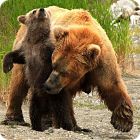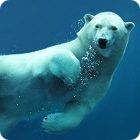bear facts
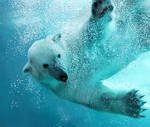
The bears are the eight species of large land mammals in the family ursidae. All the bear species are massive animals with the smallest, the sun bear, also known as the "honey bear", still weighing in at over 100 pounds.
The bear family is within the order of carnivores, and their impressive canine teeth would definitely indicate a propensity for meat, but with the exception of the polar bear, which is almost 100% carnivorous, all the bear species eat a substantial amount of vegetable matter.
The giant panda in particular eats about 95% bamboo as its diet, occasionally ingesting insects, small rodents, or other vegetation.
The brown bear (which includes the famed "grizzly bear" sub-species), is the second largest land carnivore, smaller on average only to the polar bear, yet it hunts some of the smallest prey including mice, voles, and thousands of moths in any given year, and it uses its massive jaws to collect tiny blueberries and blackberries by the dozens with amazingly delicate and dexterous lips!
Bears have extraordinary noses and their sense of smell is said to be seven times that of a bloodhound! Their eyesight and hearing, however, are probably not much better than ours.
All eight of the bear species are basically solitary animals with simple social lives, however they are considered to be some of the worlds most intelligent animals, surpassed perhaps only by the great apes, the elephants and the whales. - Bear Facts
the polar bear
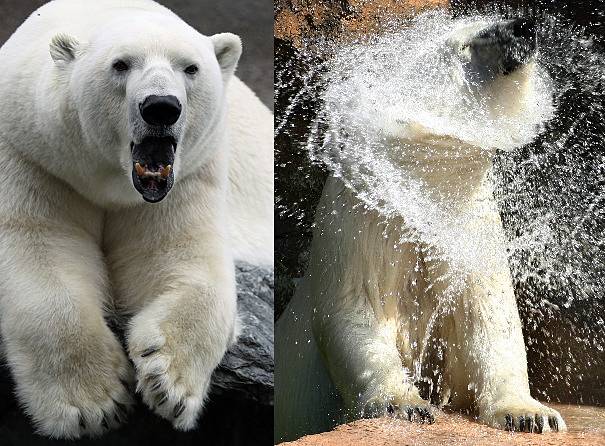
The polar bear is the largest of the eight bear species, but is probably the most recent evolutionary addition.
Diverging from the brown bear only about 100,000 years ago, the polar bear quickly evolved numerous unique physical adaptations in order to cope with its harsh arctic environment.
Polar bears have translucent fur to help trap heat, eyesight adapted to underwater viewing, and massive paws that allow them to paddle for dozens of miles in icy seas.
the brown bear
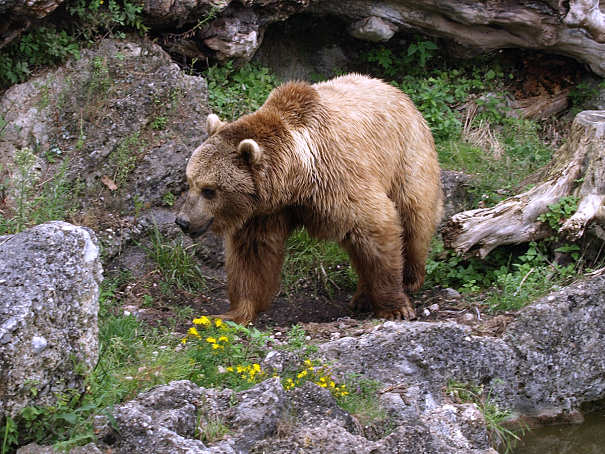 Alaskan Kodiak bear
Alaskan Kodiak bearBrown bears can be found in most heavily forested regions of the Northern hemisphere including North America, where the infamous grizzly bear resides.
There are approximately 16 subspecies of brown bear in existence, varying in size and color, and living as far south as Italy and Mexico.
Of these, the Kodiak bear of Alaska is the largest. Adult male Kodiak bears are usually just as big as adult male polar bears.
This subspecies lives on the Kodiak islands of South-West Alaska, where its reputation for enormous size is legendary.
The grizzly bear, or silver-tip bear, named so for it's grey-tipped guard hairs which give its fur a "grizzled" look, is a subspecies of brown bear. Even though all North American brown bears are sometimes referred to as grizzly bears, the fact is, all grizzly bears are brown bears, but not all brown bears are grizzly bears.
Just ask the extremely rare Marsican brown bear from central Italy!. -Bear Facts

the american black bear
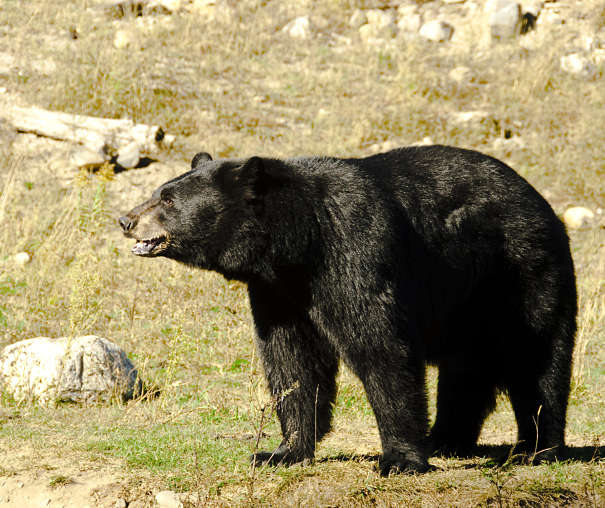
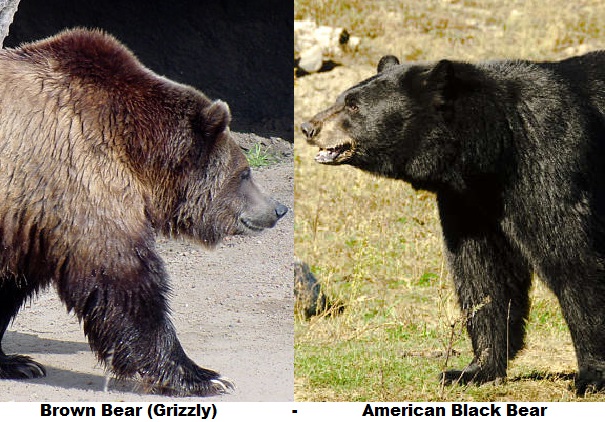
The American black bear is a medium size bear species with a large range, and perhaps the greatest variety of living environments.
Black bears are not shy among populated areas and will enter and ransack unattended sheds, buildings and even vehicles in their constant quest for food.
The black bear has a great variety of coat colors as well, being brown, red, cinnamon or even gold or buff in color. These lighter color patterns occur as you head farther west across the united states, and represent the fact that this species was named the "black" bear by the first settlers to arrive on the eastern shores.
As humans proceeded west, they believed that they were encountering different species of bear, but the colorful group all turn out to be the same species, with several regional sub-species.
The brown bear and the black bear occur simultaneously in the west and mid-western United States, and even though they may be the same color and often close to the same size (especially adult male black bears compared to adult female brown bears) but can be differentiated by the brown bears shoulder hump, dished facial profile and much larger light or even white colored claws, even though they may be the same general size and color. - Bear Facts
The asian black bear
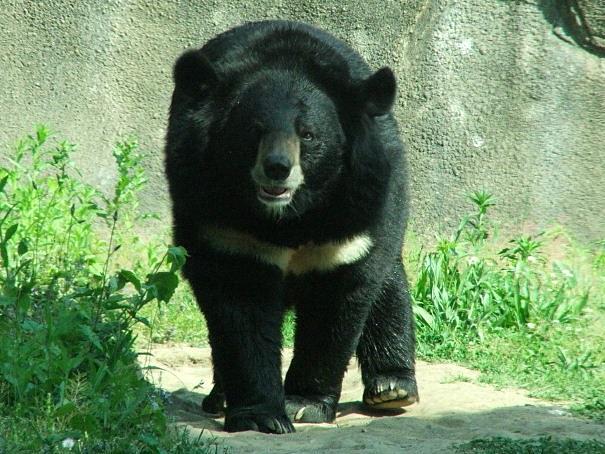
The Asian black bear is most closely related to the American black bear.
These two species diverged over 3 million years ago, but they are still more closely related than any other bear species, not having developed any special physical traits that significantly changed their DNA as the polar bears did.
The Asian black bear is slightly smaller than the American black bear, has very large (for a bear) wide-spaced ears, and a broad yellowish white mark across its chest that resembles a half moon.
Also known as the "moon bear" because of this, the Asian or Asiatic black bear is largely arboreal, spending the majority of its life on low tree branches where it forages for leaves, fruits and insects.
It ranges from the Himalayas, to Japan, and is native to Korea and most of Northeastern China and Eastern Russia.
This bear is considered to be a threatened species not only because its habitat is being destroyed, but because their body parts - especially the gall-bladder- are highly prized in Eastern medicine.
the giant panda
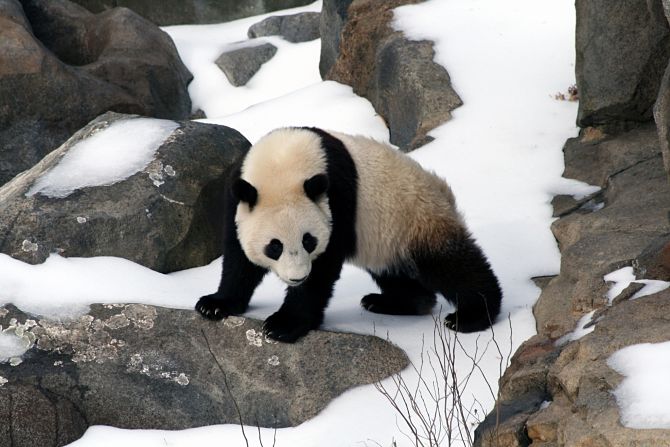
Most popular of all the bear species, the large and adorable giant panda has forgone its carnivorous history and become almost exclusively herbivorous.
Its diet is so specialized and so restricted that at any given moment a pandas stomach will never contain less than 95% of one item - bamboo!
Although there are a few different types of bamboo that pandas can enjoy, and also different parts of the plant that they may sample in season, it is still a very limited choice.
Similar to the polar bear, which may eat nothing but one species of seal for three months straight, the pandas body makes up for the nutritional limits with somewhat unusual blood chemistry, and organs such as the stomach, liver and gall bladder that work to extract as much nutrients as possible from the limited fare.
the spectacled bear
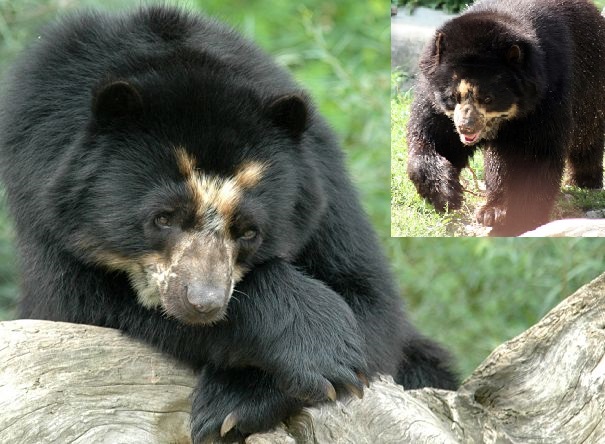
The spectacled bear is also known as the Andean bear. It is a medium size arboreal bear that inhabits the Andes mountain range of South America.
These bears are amazingly good climbers for their size, and will often build primitive nests as the great apes do, by bending over branches high in the Andes forests.
The spectacled bear is nocturnal in some parts of their range, and their diet includes flowers, tree bark and even some species of cactus!
the sloth bear
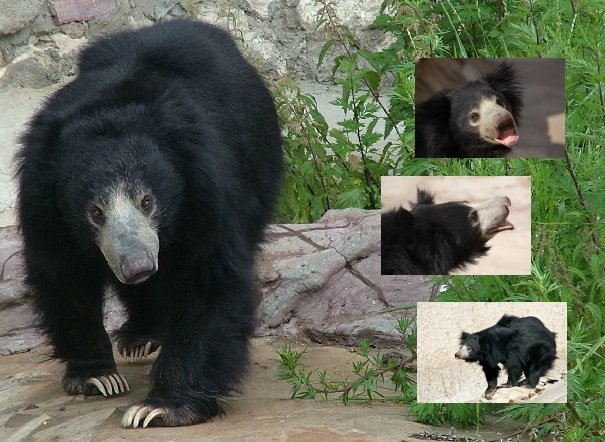
The very unusual sloth bear or Stickney bear, native to India, is probably the least known and most unique species of bear.
Nocturnal, for the most part, and also mostly insectivorous, it is most closely related to the European brown bears.
The sloth bear is medium sized but less bulky than other bear species with considerably longer limbs. It fills an ecological niche similar to that of anteaters and aardvarks, and hunts just like they do.
With long, curved claws they rip open termite and ant mounds. Then they use their specially designed lower lip to vacuum the insects up.
Sloth bears are more social than other bears with males often staying with females in dedicated pairs and even sticking around to help raise the cubs.
Like anteaters, sloth bears carry their young on their backs which is also unique among the bears.
These animals are also remarkably vocal with a number of different calls and barks, and very intelligent. They are commonly seen throughout India being used in roadside shows as dancing and performing bears. - Bear Facts
the sun bear
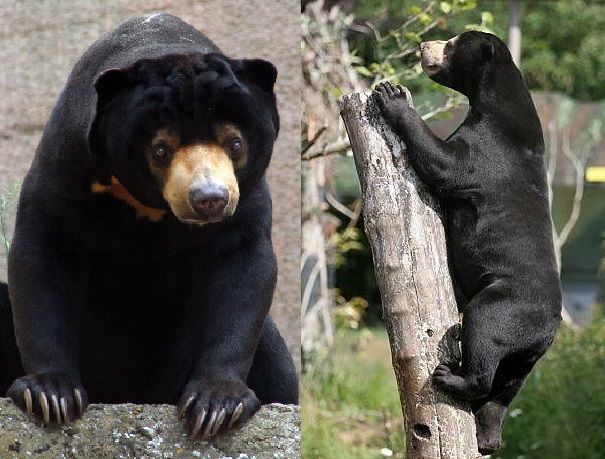
The sun bear, also called the Malaysian sun bear and the honey bear, is a unique looking creature that locally is often referred to as a "dog-bear" or "bear-dog".
The sun bear has a similar mark on its chest as the sloth bear and Asian black bear, which often takes the shape of a yellow half-moon.They are most easily distinguishable from the other bear species by the light fur color that extends to the entire face and forehead.
These are the smallest of all the eight bear species, with the largest males topping out at no more than 200 pounds and averaging more like 150 pounds.
Sun bears have the strongest sense of smell of all the bears, and tremendously strong claws and forelegs. They climb trees and forage for insects by ripping open old logs and tree trunks.
Their favorite food - not surprisingly- is honey, and they can withstand the stings of bees because their thick black fur is remarkable dense, even on the face.
Sun bears eat not only honey and honey comb, but bees, termites, grubs and caterpillars. They have a very varied diet and round it out with various fruits and plant materials.
These are strong climbing, active, and noisy animals native to tropical Southeast Asian forests, and particularly Malaysia. They range from India to Vietnam, but have difficulty adapting as their range is deforested. This is a vulnerable species in the wild, which, if the pattern of deforestation throughout their range continues, will be seriously endangered in the years to come.
A lovely, playful, and comical animal, the Malayan sun bear is also one of the most intelligent bear species. Although "Winnie the Poo" was often referred to as a "Honey bear" he clearly did not resemble the true Malaysian bear - Winnie the Poo may have been a Grizzly!.
a few more bear facts
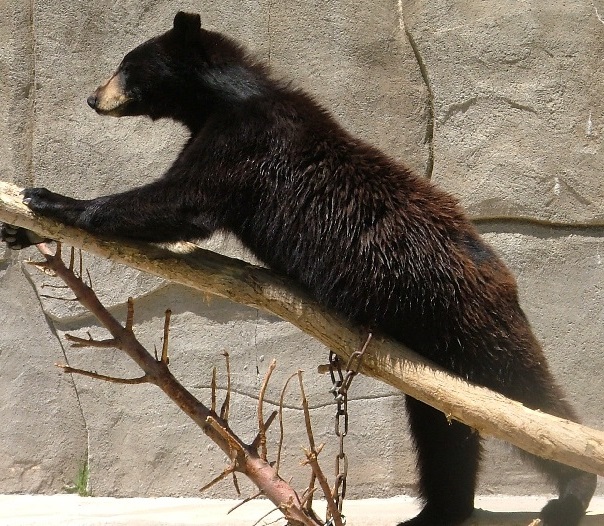
- The bears are the 8 members of the order Ursidae.
- The smallest bear species - the sun bear - is over 100 pounds
- The polar bear and the brown bear are the largest carnivores on land
- A bears sense of smell is seven times greater than a bloodhound
- The panda is a bear - the red panda (or firefox) is more closely related to a raccoon.
- The Bears are considered to be one of the most intelligent animal families behind only the great apes, the elephants and the whales.
- As one of the largest carnivores on land, the brown bear eats some of the smallest prey.
- "Dancing Bears" are common in many cultures where bears are tamed to perform in street side shows or circuses.
- Bears can walk upright and sit upright in a posture very similar to human beings. - Amazing Bear Facts
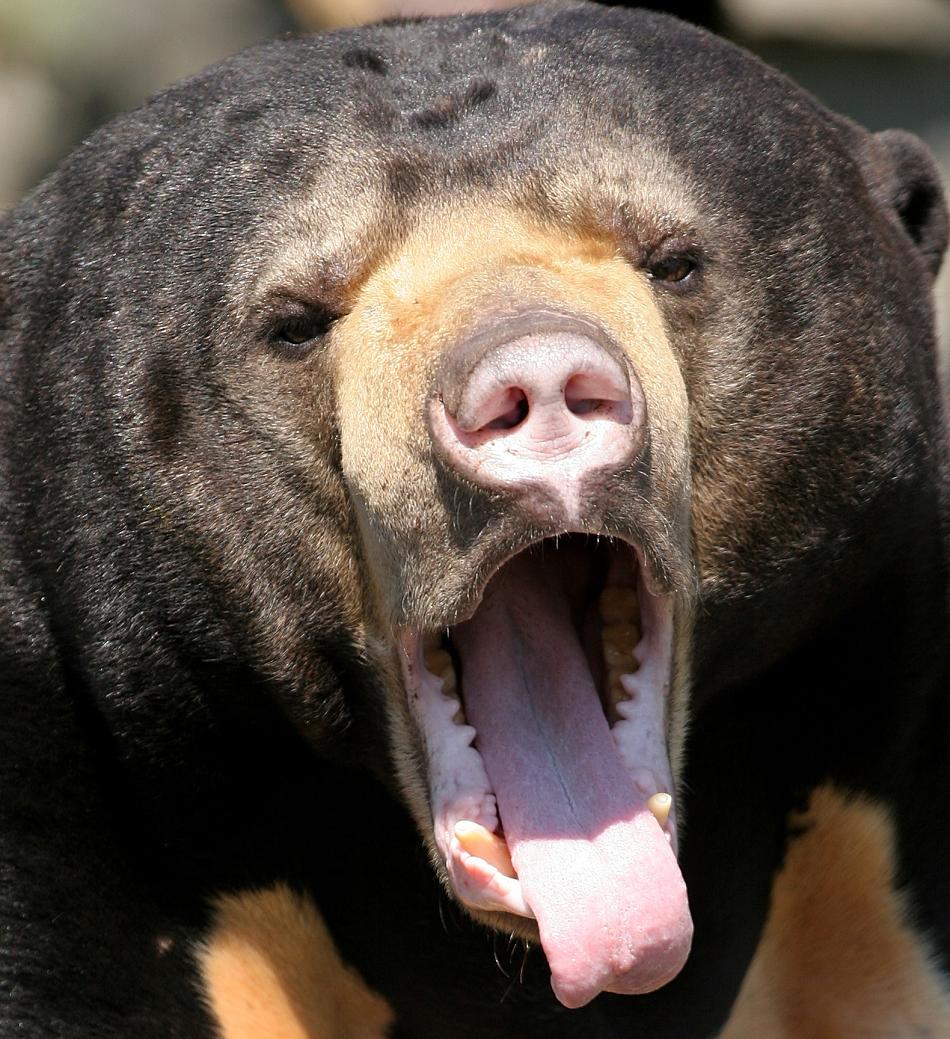
Recent Articles
-
African Animals - Animal Facts Encyclopedia
Oct 11, 16 10:27 PM
African Animals facts photos and videos..Africa is a wonderland for animal lovers, and a schoolroom for anyone who wants to learn about nature, beauty and the rhythm of life -
Baboon Facts - Animal Facts Encyclopedia
Oct 11, 16 10:26 PM
Baboon facts, photos, videos and information - Baboons are very distinctive looking monkeys with long, dog-like snouts and close set eyes. -
Great Apes Facts - Animal Facts Encyclopedia
Oct 11, 16 10:25 PM
Great apes facts, photos and videos..Human beings did not evolve from chimpanzees, modern chimps and gorillas do not appear in the fossil records until much more recently than homo sapiens..

